St. George’s Golf & Country Club, NY, USA
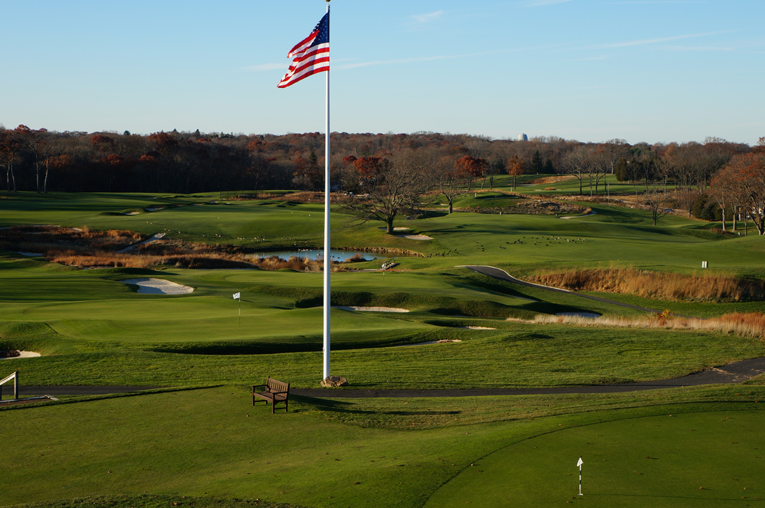
If this late autumn photograph taken from the clubhouse porch doesn’t make you itch to play golf, stop reading.
Nearly all GolfClubAtlas.com aficionados know of Charles Blair McDonald’s travels to the United Kingdom to study its great courses and his subsequent monumental achievement, National Golf Links of America, which helped earn him the moniker “father of American golf architecture.” What is less familiar is the name of Mr. McDonald’s frequent and well-heeled golf and travel partner. A very accomplished player, who also measured the great links and became a prolific designer, he “could not possibly conceive of any other use to which any given piece of real estate could be put except to lay out golf links.” Macdonald’s close friend? Devereux Emmet.
By 1911 Emmett had already achieved success building such New York gems as Garden City Golf Club and Leatherstocking. (Walter Travis would later help elevate Garden City to its present all-world status). Emmet went on to build scores of courses, many more than his confrere but the opening of National Golf Links of America that year changed everything. NGLA’s scale and its design sophistication which infused every hole with character made it the standard against which all other works in America would be judged. Apart from Seth Raynor, who was Macdonald’s construction supervisor, no one had a better vantage point to watch as NGLA unfurled than Emmet who intently studied the entire process. A few years later and after Francis Ouimet’s historic 1913 US Open victory propelled interest in golf to new heights in America, Emmet decided to build his own interpretation of what constituted great golf. The result is his undisputed masterpiece, St. George’s Golf & Country on the north shore of Long Island.
Emmet spent months scouring central Long Island. He closely examined a handful of sites before selecting today’s 150 acre parcel, which is located two miles inland from Long Island sound. Formerly the Williamson farm, the one-off landforms left from the glacial moraines that shaped Long Island piqued his interest. While the soil content is less sandy than on the southern part of the island, it is deemed sandy loam, a critical attribute for anyone who hopes to capture the finest characteristics of courses in Great Britain & Ireland.
As a man of means, Emmet was free to devote his full energy to the design and construction of St. George’s. This was going to be his course for his friends and relatives and he spent his time getting it right. It is a certainty that he gave it his all, a fact that is borne out by the quality of the individual holes today. Play commenced in 1917 and golfers were given something pleasurable to mull over on virtually every shot. The first three club champions were named Emmet but Devereux himself didn’t win until 1919; Richard and Temple Emmet won the first two. Tough family in which to get ahead!
Play back then originated from the 200 year old Williamson farmhouse located behind today’s thirteenth green and the sequence was today’s twelfth through eighteenth followed by the first through eleventh. Yes, that’s right, the course finished with a par 3 hole just like Emmet’s Garden City and Congressional. Before too long, today’s fourteenth became the opener, which meant that the epic thirteenth was the Home hole. Regardless of the sequence of holes, Emmet’s routing gives the golfer a clear sense of the property’s virtues and provides a superb mix of holes. Its downhill holes appeal for different reasons: the twisting fairway at the third, the tenth’s blind shot to a green that runs away, the roller coaster thirteenth where perfect views alternate with blind shots. What goes down has to come up and if the uphill holes are a slog, the overall merit of the course suffers proportionately. Happily, some of the climbers – the superb fifth and fourteenth – are among the course’s best.
Architecture buffs hold the Golden Age in reverence because so many enjoyable courses were produced during that 1900-1938 time frame. Yet, it’s a mistake to lump all Golden Age courses together. Styles and green sophistication evolved dramatically through this era until the start of World War II. Emmet’s crown jewel, composed in the middle of the Golden Age, was much more influenced by Macdonald than Alister MacKenzie whose naturalistic works define the latter period. Emmet and Macdonald were long time friends who traveled together extensively here and abroad. To eavesdrop on their countless conversations as they steamed to and from the British Isles and during their numerous train rides would be priceless!
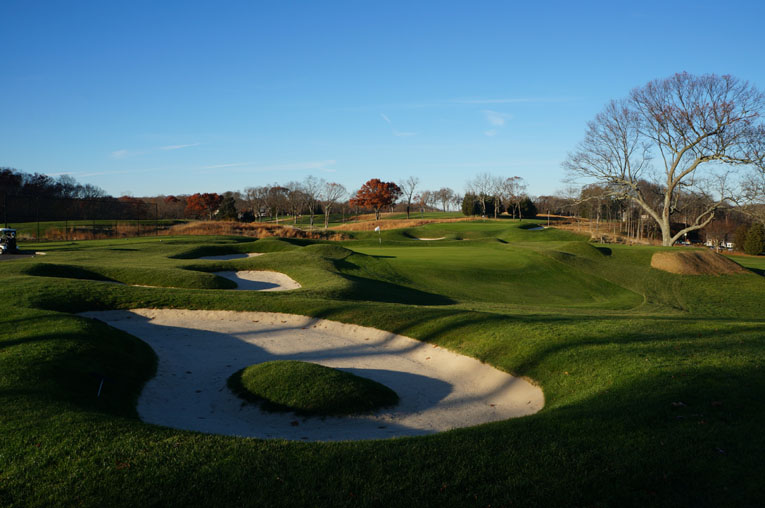
One marvels at the distinctive combination of mounds and bunkers that Emmet employed down the left of the sixteenth fairway.
Macdonald and Emmet had no compunction about building artificial mounds or bunkers with hard edges. To the author, their work symbolizes the first half of the Golden Age and exudes a charm attached to the sport’s foundation in this country. When playing NGLA, Chicago Golf Club or St. George’s, golfers can’t help but feel an intense connection to the game’s roots in the United States. Indeed, that’s very neat. And yet, St. George’s is emphatically not a museum piece, far from it. According to Canadian golf course architect Jeff Mingay, Emmet’s work remains a source of inspiration for modern architects. Mingay explains,
When we started rebuilding the Derrick Club’s course in Edmonton, Alberta earlier this year, my colleague, George Waters, and I talked a lot about how we were going to make a course that stands out as distinct in the region. There’s a dearth of classic architecture in western Canadian, so giving the Derrick an old-fashion look and feel was obvious. The real question was what flavor, exactly. Waters worked on the grounds crew at St. George’s as a kid. He has some great photos of the course that we began studying and I fell in love with the look of St. George’s. The blind hazards, deep bunkers, bizarre-looking mounds and tilted greens are clearly inspired by the classic links of the British Isles. To my eye, each and every hole at St. George’s seems to have a feature or two that makes it unique and memorable. Before we knew it, George and I were talking about Emmet’s architecture for the Derrick. Unlike a lot of his Golden Age contemporaries, Emmet didn’t seem to employ strict rules about needing to see every hazard from the tee or slavishly ensuring that every single feature perfectly harmonized with nature. As a result, parts of his courses look manufactured and certain features are quirky by today’s standards. In many ways, the attractiveness and interest of Emmet’s courses stems from this very awkwardness. The general style of his architecture is truly distinct.
In recent years, St. George’s Golf & Country Club set about highlighting what makes the course unique rather than masking its idiosyncrasies. As recently as 1995, noted course architect and critic Tom Doak was dismissive of its qualities because the course was shrouded in non-indigenous plantings which framed the greens and robbed the holes of the grandeur that existed in Emmet’s day. In the late 1990s, things took a turn for the best when the club engaged Gil Hanse to provide a Master Plan. The adoption of that plan got a shove in the right direction when Adam Jessie arrived from Shinnecock Hills as Green Keeper in 2007 and after the club board led by President John Ammerman embraced the details of Hanse’s vision the following year.
When the right Master Plan, Green Keeper and Board come together, great things can ensue – as they did here in grand fashion! Today’s course bears little resemblance to 1995’s and displays all of the charm and character that existed when Emmet was alive. Put another way, today it is easy to appreciate why Emmet became so enamored with the property and the one of a kind landforms that gave him the platform to build his defining work. Also, the open farmland lent the course a sense of spaciousness generally reserved for links or heathland golf. Add in the texture that Jessie and the club have since carefully cultivated and you end up with a visually striking course. According to Ammerman,
To maintain our focus during each phase of the restoration project we continued to revisit the overarching purpose of the project. That purpose being to unearth the true heart & soul of St. George’s, which is rooted in the great links courses of the British Isles that Emmet understood so well. He conducted detailed studies of those courses with the aim to bring their enduring qualities back to American soil. As Emmet’s home course, it was our goal to have St. George’s once again represent his opus to those great courses. To do so, our restoration efforts were somewhat akin to an archeological dig. With the guidance of Gil Hanse, the historic bones of our course have been uncovered for all to see. Our green committee and Green Keeper Adam Jessie really sank their teeth into the project, patiently following Gil’s plan of restoring width and shot options throughout the design. We now have 31 acres of short fairway grass versus 22 acres when we commenced and that has brought many of Emmet’s bunkers back into play. In essence we peeled back the folds of time to reveal the classic course Devereux Emmet envisioned.
Though National Golf Links is bigger (it is built on more land with wider fairways and longer holes), St. George’s shares its defining characteristic: startlingly unique holes on American soil. Many of NGLA’s holes have famously been used as templates and their design principles replicated at several dozen courses. The same is not true for St. George’s; most of it is as fresh today as when the course opened. Its most distinctive holes (and there are many) are featured below.
Holes to Note
Third hole, 410 yards, Perfection; Considering Emmet’s love of classic golf it’s no surprise that the golfer is unlikely to see his ball finish in the fairway on a third of the holes. Here the fairway plunges sharply downhill and out of view over the hill’s brow but its cant to the left provides golfers the real opportunity to have their tee ball find the only level patch of fairway long down the left side.
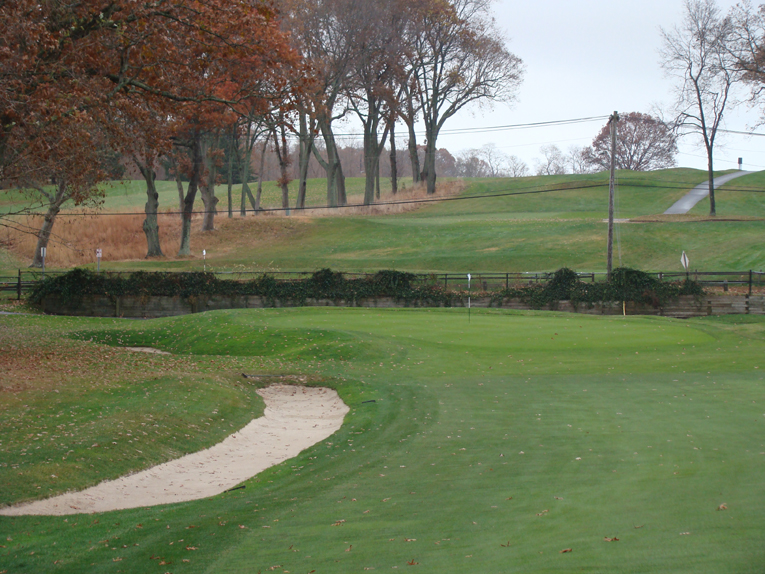
Look at this nearly 50 yard long strip bunker. While a naturalist like Alister MacKenzie might not build it, it exudes historic appeal. Golfers face bunkers like this one placed at the bases of long slopes throughout the round. Such bunkers play bigger than they look as balls are swept into them from well away.
Fourth hole, 360 yards, Stey Brae; Though Golden Age architects generally didn’t believe in doubly penalizing golfers, stacked bunkers (i.e. one bunker in front of another) are featured here. Rare Golden Age examples include the pair of bunkers at the foot of the ninth green at Essex County north of Boston and the ones front right at the seventeenth green at Southern Hills. Yet, everywhere with which the author is familiar, the front bunker is always the lower one. In a positively unique twist, Emmet built the front bunker at grade with the fairway and hid a seven foot deep moat bunker behind it. The massive pushed up green pad is equally bold and is bunkered left, right and wrapped behind by a good old fashioned ninety degree inverted L shaped bunker. Though Emmet moved a lot of dirt in the creation of this green complex, he did so in a manner that appears as if he hadn’t. This is one of the most distinctive green complexes in world golf, all thanks to the imagination and creativity of Emmet. The blind drive up a hill isn’t riveting and this finger of the property up top is uncharacteristically featureless, yet Emmet built a singular hole. That’s architecture at its best with man creating the golfing appeal when nature didn’t.
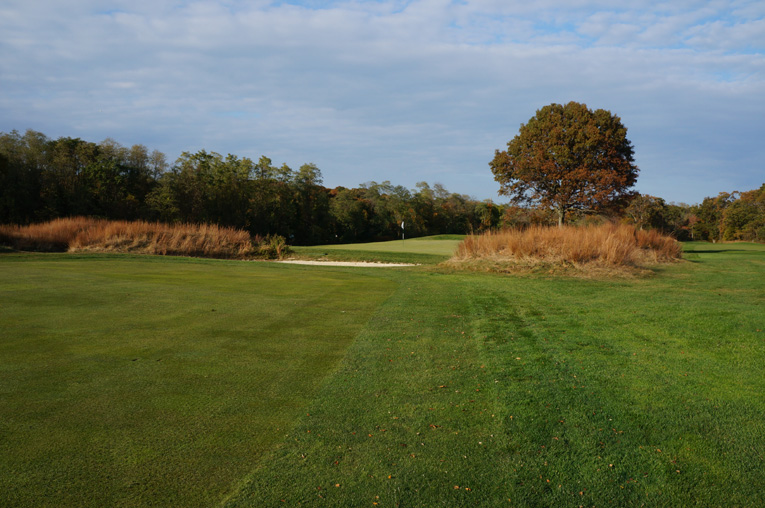
From the fairway, the task at hand seems mundane. Nothing could be further from the truth! Little does the first time player appreciate that behind the first flat surface bunker seen above is …
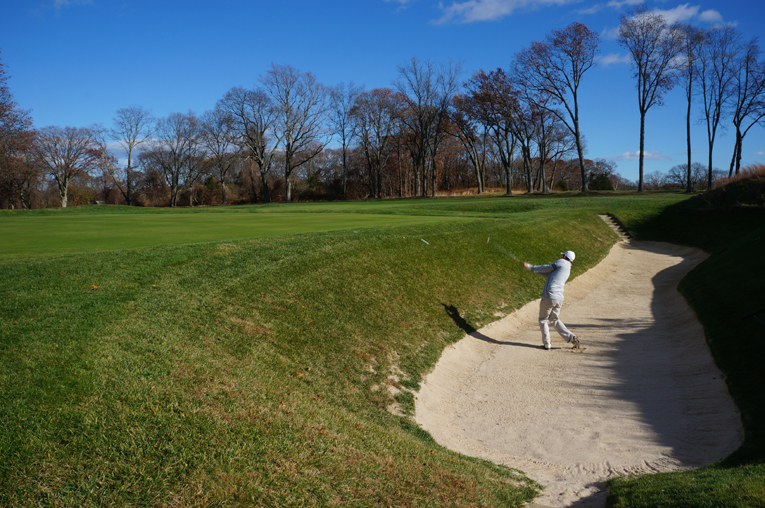
… a moat bunker that is deeper than most golfers are tall. The bank behind the golfer indicates the steep drop from the front bunker into this one.

This panoramic view captures the unique nature of the fourth’s green complex. Surrounded on all sides by bunkers, this surely could be considered one of the first ‘island’ greens. Nothing remotely close to such a manufactured green complex was built prior to 1900. Indeed, the author contends that the some of NGLA’s famous green pads both inspired and emboldened Emmet.

Call them old fashioned but Emmet’s irregularly shaped hazards act as genuine hazards. This golfer is fortunate to enjoy a good stance in the trench bunker at the rear of the green.
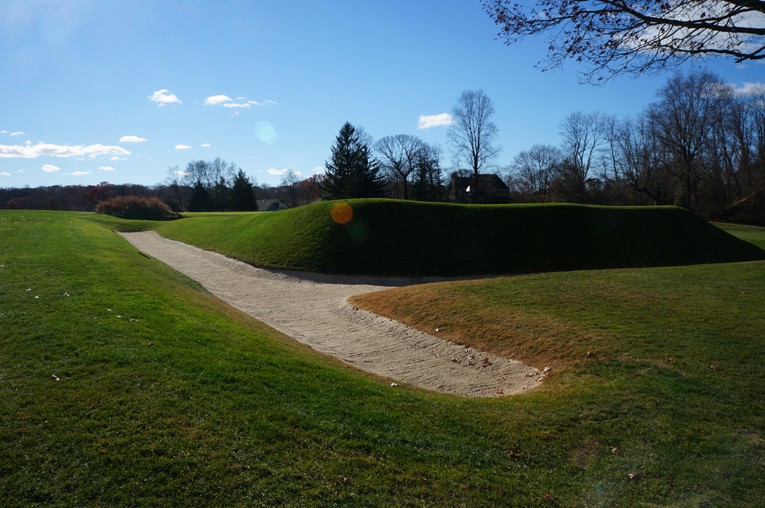
This view from back right of the green highlights Emmet’s unique bunkering style as well as the volume of fill used to create the green pad. To appreciate the fourth is to understand the architect. It occupies a section of the course’s less appealing property yet is one of the best holes; thanks to Emmet’s creativity.
Eighth hole, 380 yards, Dog’s Leg; Measuring less than 6,300 yards, the tiger might think that he will have his way with St. George’s. Yet, par is a tight 70 and bunches of birdies never seem to materialize. This hole with its two magnificent bunkers and imaginative green contours epitomizes how Emmet packed a punch every step of the way.
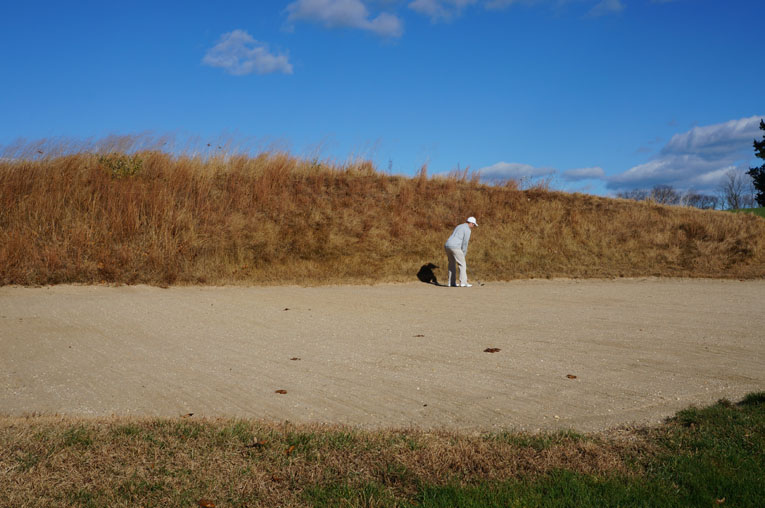
Emmet cut this nine foot deep bunker into the brow of the hill that the golfer drives over at the eighth.
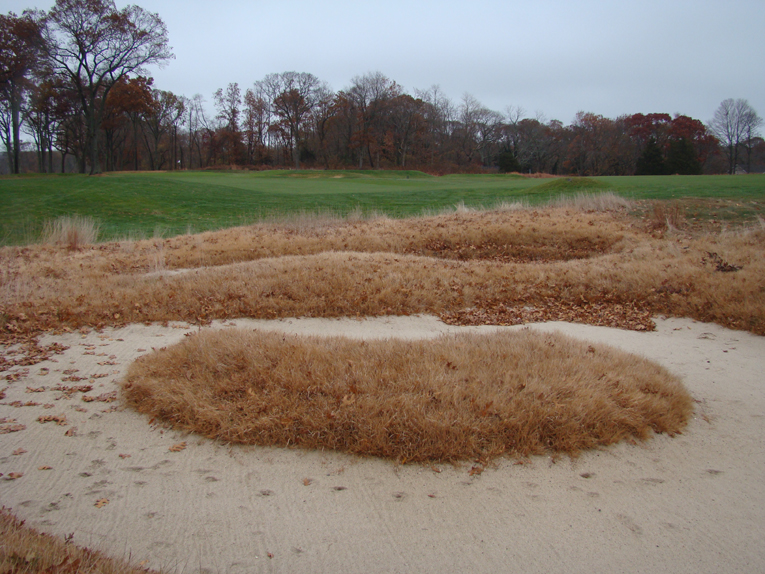
Thirty yards farther ahead, and blind from the tee, this island bunker is surely a byproduct of Emmet’s tours of Great Britain.
Tenth hole, 375 yards; The original access road to the Williamson farmhouse runs through the course with holes four through ten located on the opposite side. As its delightfully antiquated name ‘Lower Sheep Pasture Road’ implies, the road was an integral part of Emmet’s routing. The placement of the tenth green at the base of the hill sandwiched against the road was especially clever. Similar to the one shot seventh, the area five to twenty yards short of the green becomes the golfer’s focus.
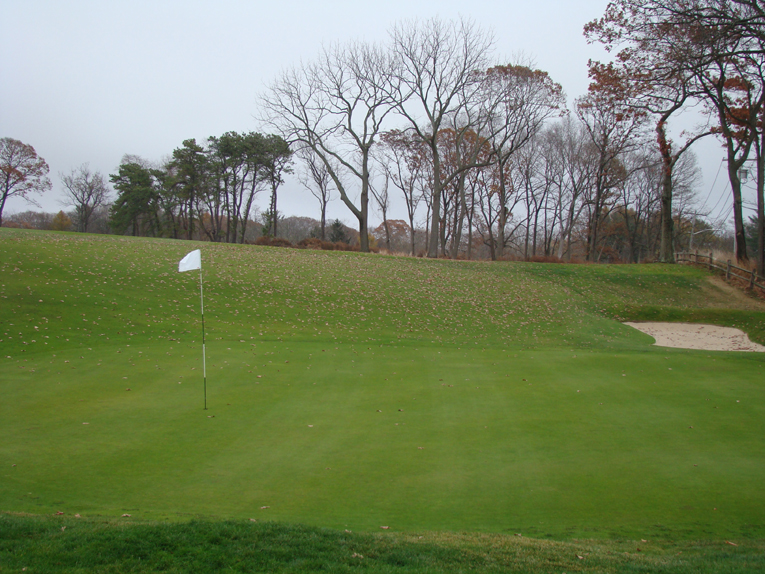
Quite the contrary, the flagpole is extra long as seen from behind the tenth green. Each golfer elects where on the hill to land his approach shot. The green follows the natural grade of the terrain, sloping from front right to back left. Another one of St. George’s gathering bunkers sucks in errant approach shots as the ground’s cant and fairway grass deposit balls into it.
Eleventh hole, 195 yards, Maiden; These next five holes pack a wallop. Even the ace player who is in good form can see strokes mount. This attractive high point to high point one shotter leaves daunting pitches to a large tilted green for shots that come up short or right. Think about how nicely this green which rewards an aerial approach compliments its predecessor whose putting surface readily accepts low punched, running shots. Constantly shifting shot requirements are the hallmark of great designs.
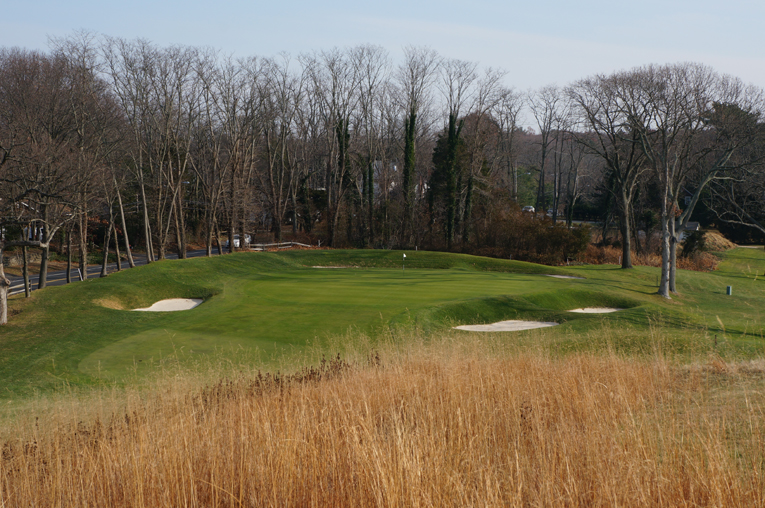
Emmet wasn’t afraid to use mounds occasionally to frame his greens. Tee balls pulled at the eleventh that hit on the wrong (i.e. left) side of the mounds are certain to find out of bounds.
Twelfth hole, 420 yards, Needle E’s; Emmet’s routing is a genuine tour of the old farmland with holes leading into each and every corner. The twelfth plays down to the property’s low point before rising to a green Emmet benched seamlessly into the hillside. Upon completion of a tree management initiative, it is the only hole with trees both left and right along its playing corridor. As such, the twelfth enjoys its own personality and adds to the overall variety and fabric of the course as a whole.
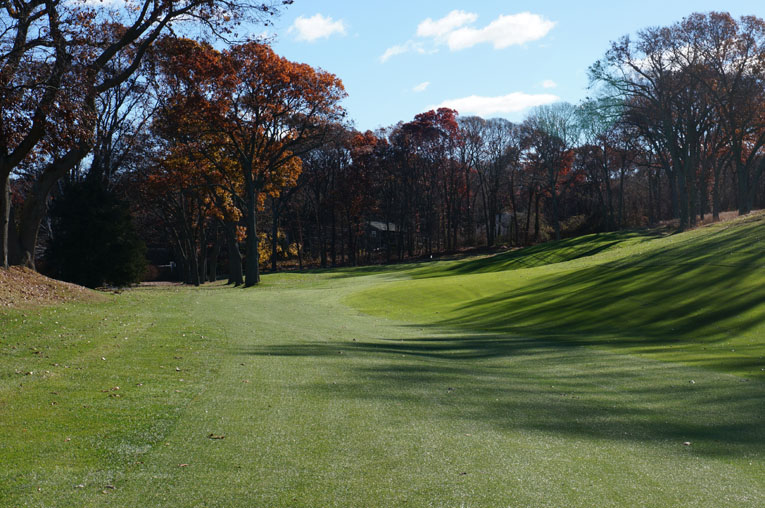
Visually, the twelfth looks like the tightest drive on the course but the fairway plays wide as tee balls kick off the right hillside.

Nestled alone in a corner of the property, the twelfth enjoys a different flavor than the exposed holes.
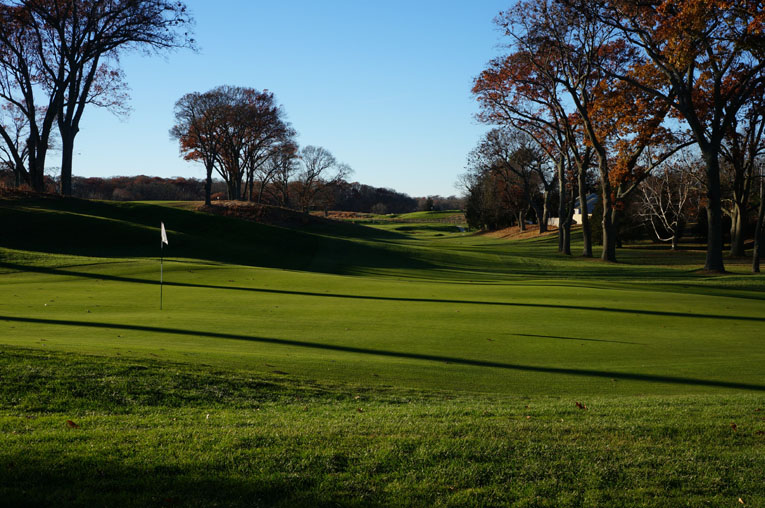
As seen from behind, note the tilt and wonderful ripples that define the challenge in holing out at the twelfth.
Thirteenth hole, 450 yards, The Knoll; One of the hardest holes on Long Island, this is “lay of the land” architecture at its best as there is no clear way to play it. Drive too far and you’re guaranteed a blind approach shot. Lay back too much and you can’t reach the green. A hole like this can’t be replicated elsewhere because its rambunctious landforms are so rare. In this case, the fall from the top of the fairway to the green is 26 feet. Mother Nature clearly gets her due but so should Emmet for seizing the dramatic landscape and enabling good golf. This looks and feels like a Home hole – and indeed it was (!) up until 1929 when the clubhouse was relocated to its current glorious perch.
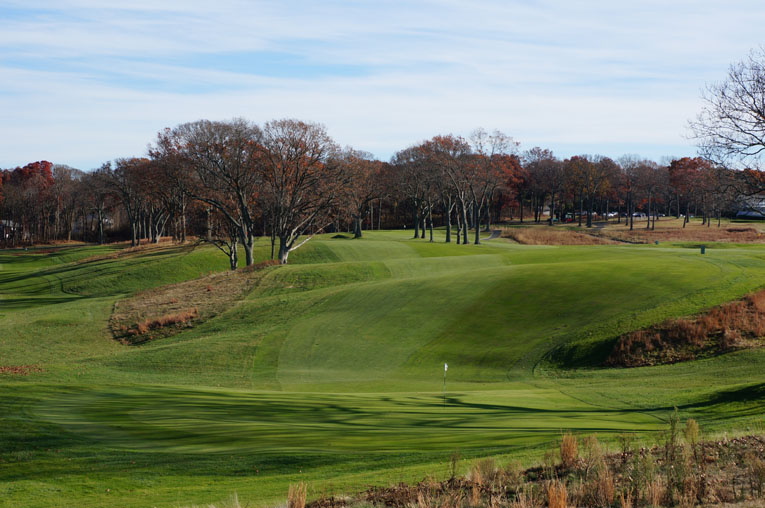
This view from behind the thirteenth green highlights St. George’s magnificent topography. Eastward Ho! on Cape Cod and its rollicking fairways that were also shaped by glacial moraines provide one of the few comparisons in golf. Note the folds back high in the fairway. In a true links manner, the golfer will see the flag some days for his approach but not on others.
Fourteenth hole, 390 yards, Drum Sichty; The heart of the back nine (and for that matter, the course) consists of six parallel holes. The second-eighteenth-sixteenth-fourteenth-thirteenth-twelfth fairways play more or less along an east/west axis. The thought of so many parallel holes would normally make one cringe but the variety found within this segment of the course is astonishing. The fourteenth is sandwiched in the middle of this glorious stretch and the author has never seen a straight hole play in such a non-linear manner! The high point of the fairway lies near its middle. Consequently, draws feed left and fades peel right making divots quite rare in the middle of the topsy-turvy fairway. This exacerbates the approach to the large angled green, which starts front left and climbs four feet to reveal some newly reclaimed, wicked back right hole locations.
Fifteenth hole, 165 yards, Bastion; This green possesses defiant interior contours to the point where legend has it that Saint George slew a dragon and buried it beneath the putting surface. Emmet throws lots of different looks at the golfer throughout the round (the walled off fourth green complex, the open tenth that begs for a running approach, the knob seventeenth). The targets (i.e. the greens) are intermediate in size, averaging 4,575 square feet. This one is larger and gave Emmet space to ‘bury the dragon’ and its humps have confounded several generations of golfers. Right handed hole locations are vicious thanks to the firm playing surfaces and the sloping, short grass banks presented by Jessie. Knowing this, more than one member hits the ball ‘safely’ left only to find himself on the wrong side of the humps. An indelicate putting effort can see the ball roll past the hole, off the green, and into the bunkers at the base of the green pad.

The domed putting surface makes the fifteenth play every bit as good as it looks. As part of the club’s continued march toward perfection, the cart path above will be altered/removed in 2014.

From back right of the green, one readily appreciates the menace posed by the tandem of the short grass and slopes that feed off the fifteenth green complex.
Sixteenth hole, 320 yards, Water Kelpie; As he did at Garden City Golf Club and throughout his more noted designs, Emmet employed small mounds. Fields of mounds are used to separate playing corridors between this hole and the Home hole and also ring the green at the next. When they are low and randomly placed, such mounds lend playing interest while providing an old fashioned feel. More importantly, they dish out a wide variety of stances and lies for those who encounter them. If they are avoided on the tee shot and the fairway is found, the sixteenth becomes an opportunity to repair one’s score from the bloodshed that likely occurred on the preceding five holes.
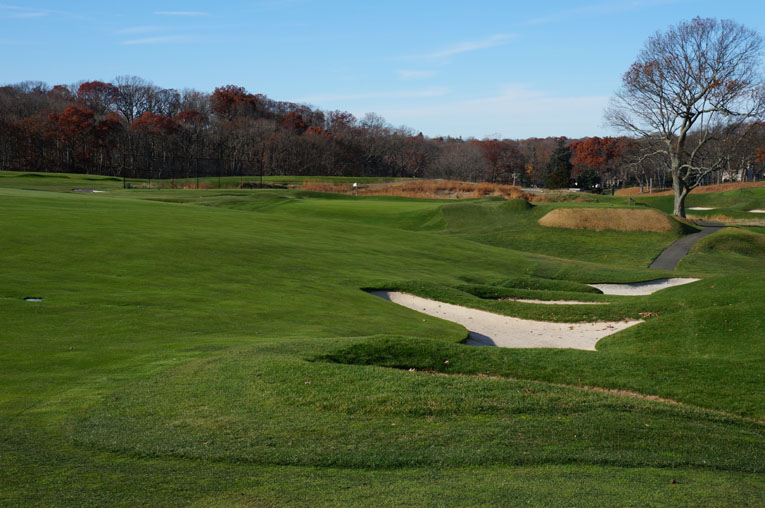
The big picture at St. George’s looks great these days; now Jessie and his crew focus on getting the small details right like having the sixteenth fairway flow directly into this string of fairway bunkers down the lower right side of the sixteenth fairway. St. George’s remains liberally bunkered with 117 sand pits. As seen above and elsewhere throughout this profile, many are ‘gathering’ in nature, an attribute that Jessie delights in maximizing.
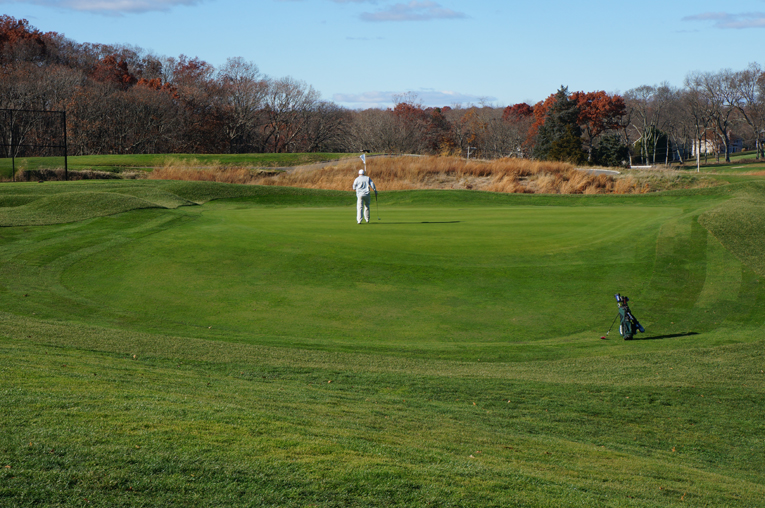
This disconsolate golfer just finished repairing his ball mark on this evilly small, sub-3,000 square foot green. At one point, he had high hopes for his short iron approach. Instead, he finds his ball well back down the hill to just in front of his bag, leaving a ticklish recovery from tight short grass.
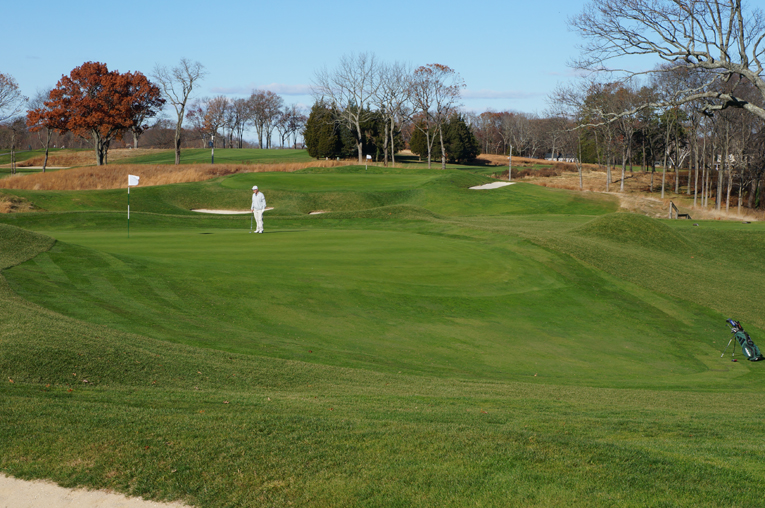
The drive and pitch sixteenth green is in the foreground and the tiny one shot seventeenth is in the back. Together, they represent two of the most demanding back-to-back short iron shots in the game. Why? In part because their combined green size is barely over 6,100 square feet. To put that in perspective, the 16th and 17th greens are the size of a single green that was typically built in the 1960s and 1970s. Such small targets in a windy environ like Long Island inevitably prove hard to find. To make matters even more taxing, many of the ensuing recovery shots are no bargain either.
Seventeenth hole, 125 yards, Sunken Forest; One of the most unusual penultimate holes in golf is all the better for it. It’s tempting to consider this a kin of Herbert Strong’s ‘2 or 20’ hole located at Engineers Country Club some thirty miles away. It is simply a hit it or else proposition featuring a tiny green (3,165 square feet) fronted by a pair of 13 foot deep bunkers. One might take comfort in its short length but that’s before hoisting a wedge high into the air on a windy day. Unlike long par threes, every golfer steps on this tee knowing – in theory – that this hole is within his playing ability. Reality can deliver an altogether different, harsher message. The false front is almost 25% of the putting surface, reducing the hitting area to well under 2,500 square feet.

In this age of perfect mechanics and hundred and thirty mile per hour club speed, length is rendered immaterial. To test the best, architects need to throw in some fiddly shots that compel strong players to gear down. That’s an effective way to distinguish the player from the range jockey.
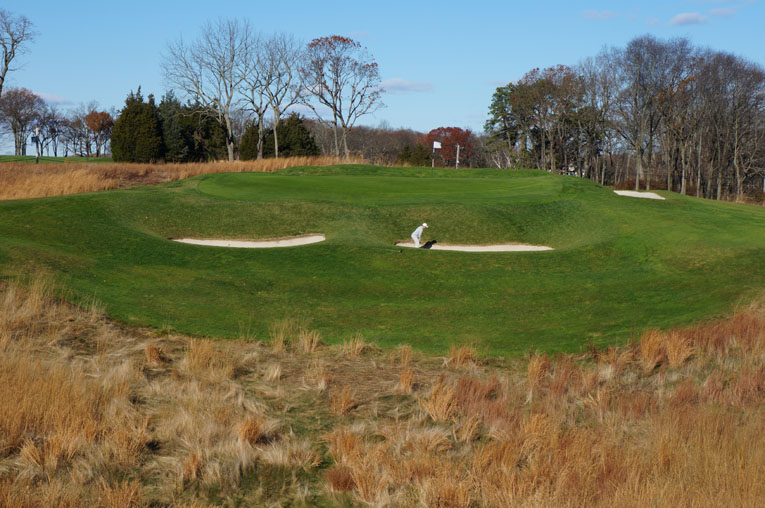
The golfer provides a sense of scale to the nasty pits that front the seventeenth green. One also gains a sense of the wicked nine yard long false front. If the golfer in the bunker doesn’t carry his recovery shot at least twenty yards, he will likely get another chance. The only good news? Today’s 60 degree sand wedges make recovery shots much easier than in the days of hickory shafted niblicks (a.k.a. today’s nine iron)!
Eighteenth hole, 535 yards, Hame; The hole’s name is not a typo, it merely reflects Emmet’s appreciation for the Scots and their brand of golf. For many reasons – its whopping (!) 22 bunkers, the most pronounced interior green contour on the course, and its 1/2 par nature – this is one of the game’s most interesting Home holes. It played originally as the eighth hole and later as the sixth until the club borrowed money to build the long winding entrance drive and clear the land in 1929. As this was the start of the Great Depression, it was hardly the ideal time to build a clubhouse. Yet, Emmet was already up in years and he would pass away in 1934. One presumes he pushed hard to see the clubhouse completed at its present high location during his lifetime. Its location affords sweeping views across nearly half the course and allows the course to build through the round, ending with one of the great nine holes on Long Island or anywhere for that matter. For some members, their favorite par 4, par 3 and par 5 on the course are the last three holes. It was a stroke of genius and good for Emmet that he got to see it here during his lifetime. His dream course was fully realized.
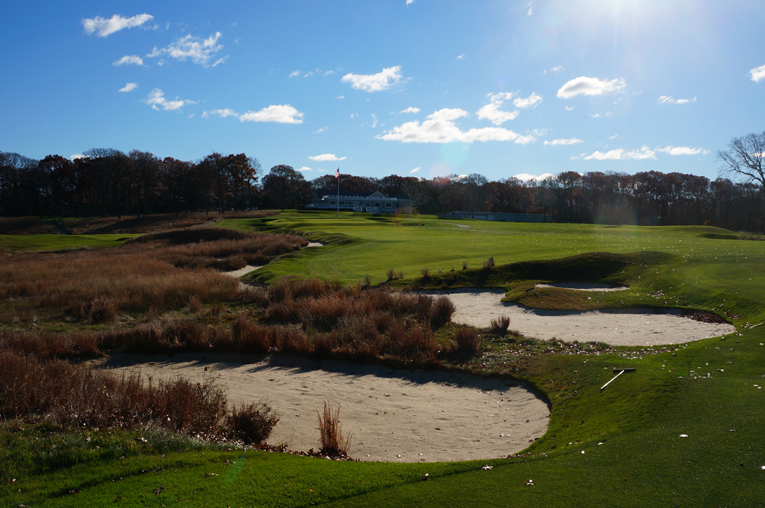
Can the golfer hit a bullet three wood and perhaps reach the putting surface in two? It is a thrilling shot to try. Most golfers play well away from the broken ground that is strewn with bunkers and look to pitch the ball onto the two tiered green in three.

A delicate shot from a tight lie is often times the last thing that a golfer wishes to confront late in the round when his nerves are frazzled. Note the big knob seen underneath the flagpole; its presence signifies the divide between the lower (easier) and upper (harder) portions of the green. Hole locations on the lower tier can yield birdies as golfers use the tier as a backstop. Accessing upper hole locations requires a more deft approach – the third one in as many holes. St. George’s preys on the golfer’s nerves coming down the stretch like few other courses.
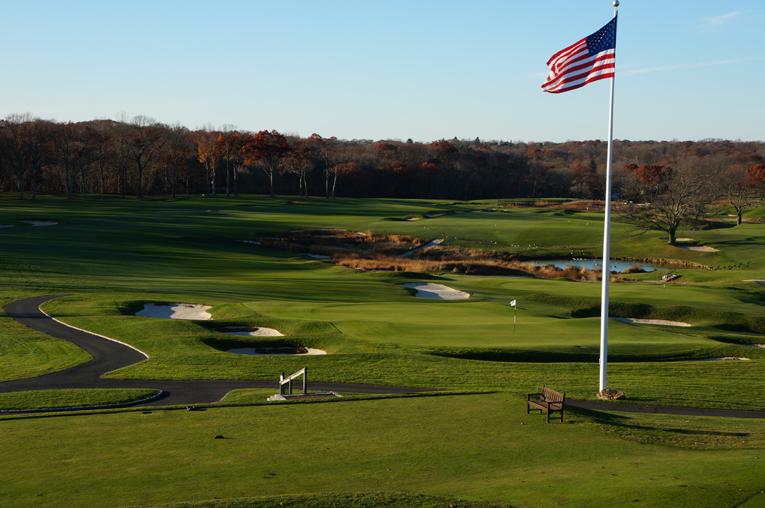
This view from behind the eighteenth green shows both the ridge through the green as well as the hole’s right to left elbow. What a spot to enjoy a refreshment afterwards! This large open area, which houses a third of the holes, is the American fescue version of a heath in England. Many consider heathland golf as golf’s finest inland form.
Situated on Long Island, St. George’s is surrounded by world class golf. Getting recognition in such a tough neighborhood isn’t easy, even though St. George’s would be the best course in at least half the American states. One wonders why a course with so many stand-out holes isn’t better appreciated. The answer is that Emmet’s achievements weren’t on full display from the 1960s through 2000. My how things have changed! Now the club/course is set to get its proper due. So too is Emmet who has been an underappreciated central figure during the Golden Age because his key designs like this one weren’t well presented. With his treasure at St. George’s near his family estate back in full force, his own distinctive brand of golf course architecture can be heralded once again.
The End


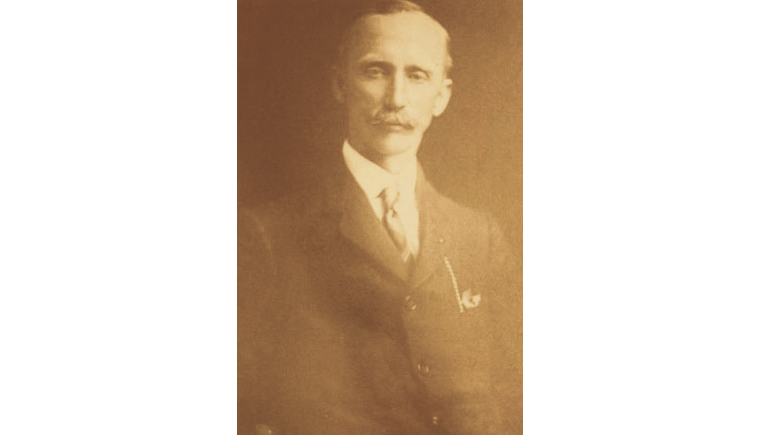
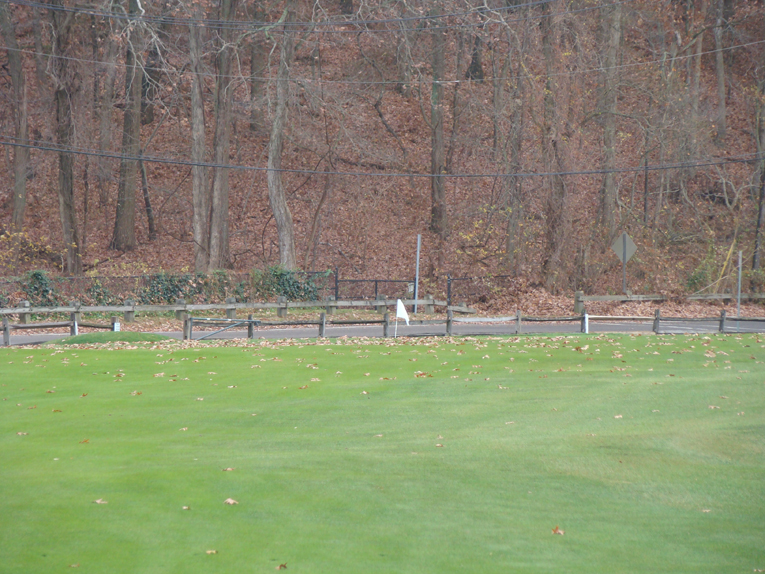
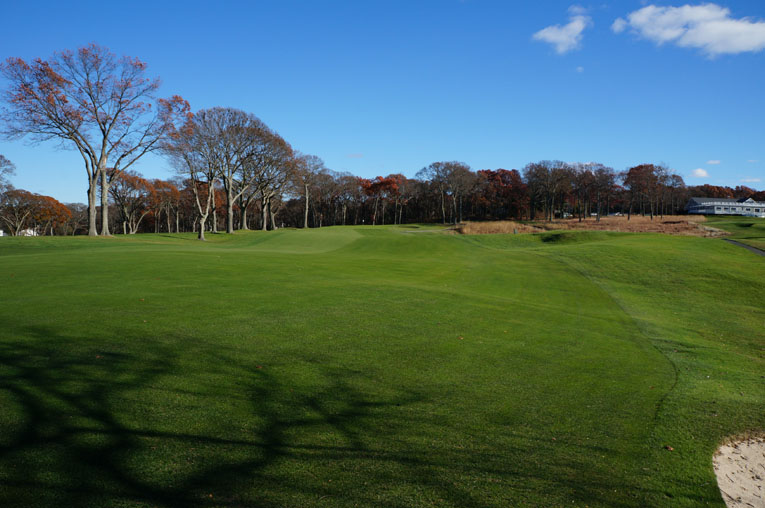




![The Park, West Palm (Lit 9) [2023]](https://golfclubatlas.com/wp-content/uploads/2024/12/IMG_7092-2-scaled-500x383.jpg)


